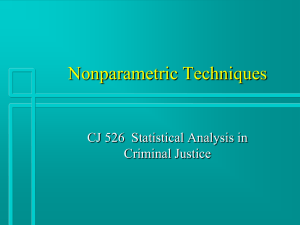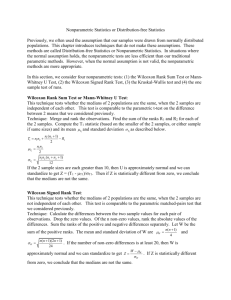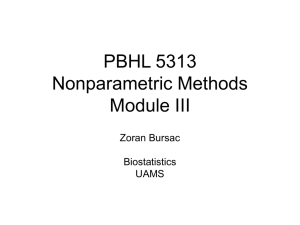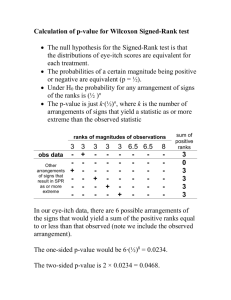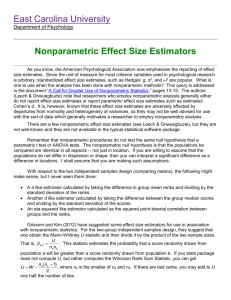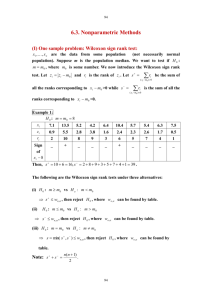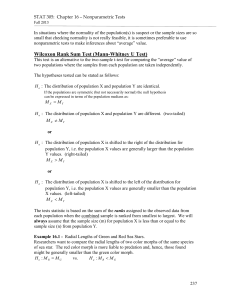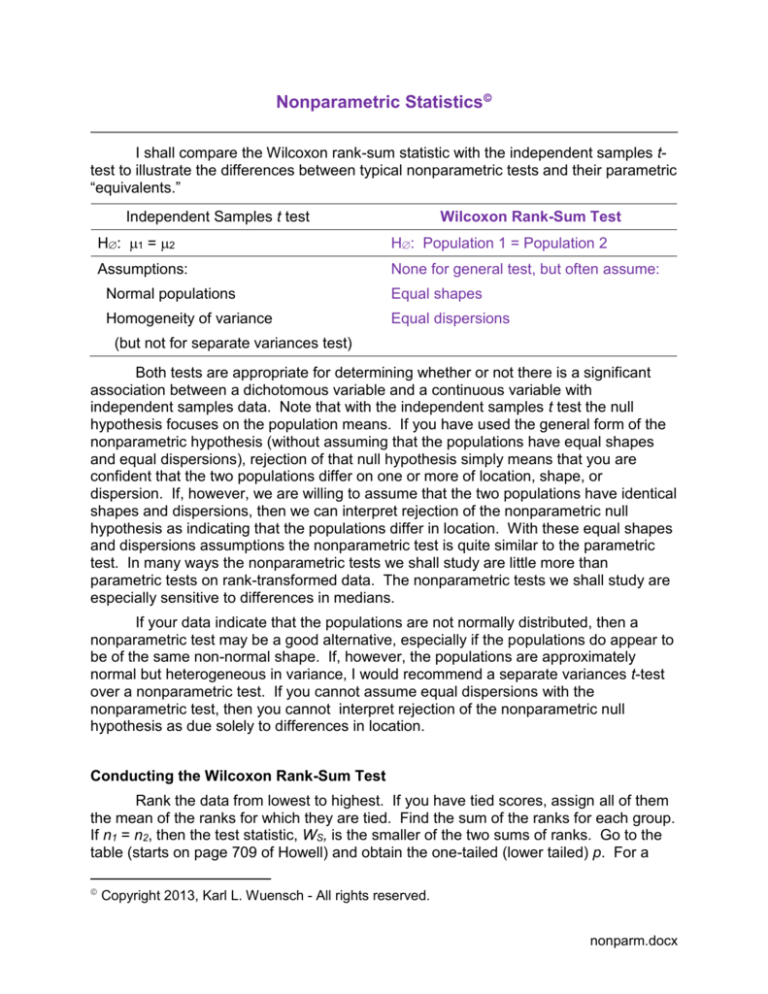
Nonparametric Statistics
I shall compare the Wilcoxon rank-sum statistic with the independent samples ttest to illustrate the differences between typical nonparametric tests and their parametric
“equivalents.”
Independent Samples t test
Wilcoxon Rank-Sum Test
H: 1 = 2
H: Population 1 = Population 2
Assumptions:
None for general test, but often assume:
Normal populations
Equal shapes
Homogeneity of variance
Equal dispersions
(but not for separate variances test)
Both tests are appropriate for determining whether or not there is a significant
association between a dichotomous variable and a continuous variable with
independent samples data. Note that with the independent samples t test the null
hypothesis focuses on the population means. If you have used the general form of the
nonparametric hypothesis (without assuming that the populations have equal shapes
and equal dispersions), rejection of that null hypothesis simply means that you are
confident that the two populations differ on one or more of location, shape, or
dispersion. If, however, we are willing to assume that the two populations have identical
shapes and dispersions, then we can interpret rejection of the nonparametric null
hypothesis as indicating that the populations differ in location. With these equal shapes
and dispersions assumptions the nonparametric test is quite similar to the parametric
test. In many ways the nonparametric tests we shall study are little more than
parametric tests on rank-transformed data. The nonparametric tests we shall study are
especially sensitive to differences in medians.
If your data indicate that the populations are not normally distributed, then a
nonparametric test may be a good alternative, especially if the populations do appear to
be of the same non-normal shape. If, however, the populations are approximately
normal but heterogeneous in variance, I would recommend a separate variances t-test
over a nonparametric test. If you cannot assume equal dispersions with the
nonparametric test, then you cannot interpret rejection of the nonparametric null
hypothesis as due solely to differences in location.
Conducting the Wilcoxon Rank-Sum Test
Rank the data from lowest to highest. If you have tied scores, assign all of them
the mean of the ranks for which they are tied. Find the sum of the ranks for each group.
If n1 = n2, then the test statistic, WS, is the smaller of the two sums of ranks. Go to the
table (starts on page 709 of Howell) and obtain the one-tailed (lower tailed) p. For a
Copyright 2013, Karl L. Wuensch - All rights reserved.
nonparm.docx
2
two-tailed test (nondirectional hypotheses), double the p. If n1 n2, obtain both WS and
WS : WS is the sum of the ranks for the group with the smaller n, W S 2W W S (see
the rightmost column in the table), the sum of the ranks that would have been obtained
for the smaller group if we had ranked from high to low rather than low to high. The test
statistic is the smaller of WS and WS. If you have directional hypothesis, to reject the
null hypothesis not only must the one-tailed p be less than or equal to the criterion, but
also the mean rank for the sample predicted (in H1) to come from the population with
the smaller median must be less than the mean rank in the other sample (otherwise the
exact p = one minus the p that would have been obtained were the direction correctly
predicted).
If you have large sample sizes, you can use the normal approximation
procedures illustrated on page 672 of Howell. Computer programs generally do use
such an approximation, but they may also make a correction for continuity (reducing the
absolute value of the numerator by .5) and they may obtain the probability from a tdistribution rather than from a z-distribution. Please note that the rank-sum statistic is
essentially identical to the (better know to psychologists) Mann-Whitney U statistic. but
the Wilcoxon is easier to compute. If someone insists on having U, you can always
transform your W to U (see page 673 in Howell).
Here is a summary statement for the problem on page 672 of Howell (I obtained
an exact p from SAS rather than using a normal approximation): A Wilcoxon rank-sum
test indicated that babies whose mothers started prenatal care in the first trimester
weighed significantly more (N = 8, M = 3259 g, Mdn = 3015 g, s = 692 g) than did those
whose mothers started prenatal care in the third trimester (N = 10, M = 2576 g, Mdn =
2769 g, s = 757 g), W = 52, p = .034.
Power of the Wilcoxon Rank Sums Test
You already know that the majority of statisticians reject the notion that
parametric tests require interval data and thus ordinal data need be analyzed with
nonparametric methods (Gaito, 1980). There are more recent simulation studies that
also lead one to the conclusion that scale of measurement (interval versus ordinal)
should not be considered when choosing between parametric and nonparametric
procedures (see the references on page 57 of Nanna & Sawilowsky, 1998). There are,
however, other factors that could lead one to prefer nonparametric analysis with certain
types of ordinal data. Nanna and Sawilowsky (1998) addressed the issue of Likert
scale data. Such data typically violate the normality assumption and often the
homogeneity of variance assumption made when conducting traditional parametric
analysis. Although many have demonstrated that the parametric methods are so robust
to these violations that this is not usually a serious problem with respect to holding
alpha at its stated level (but can be, as you know from reading Bradley's articles in the
Bulletin of the Psychonomic Society), one should also consider the power
characteristics of parametric versus nonparametric procedures.
While it is generally agreed that parametric procedures are a little more powerful
than nonparametric procedures when the assumptions of the parametric procedures are
3
met, what about the case of data for which those assumptions are not met, for example,
the typical Likert scale data? Nanna and Sawilowsky demonstrated that with typical
Likert scale data, the Wilcoxon rank sum test has a considerable power advantage over
the parametric t test. The Wilcoxon procedure had a power advantage with both small
and large samples, with the advantage actually increasing with sample size.
Wilcoxon’s Signed-Ranks Test
This test is appropriate for matched pairs data, that is, for testing the significance
of the relationship between a dichotomous variable and a continuous variable with
related samples. It does assume that the difference scores are rankable, which is
certain if the original data are interval scale. The parametric equivalent is the correlated
t-test, and another nonparametric is the binomial sign test. To conduct this test you
compute a difference score for each pair, rank the absolute values of the difference
scores, and then obtain two sums of ranks: The sum of the ranks of the difference
scores which were positive and the sum of the ranks of the difference scores which
were negative. The test statistic, T, is the smaller of these two sums for a
nondirectional test (for a directional test it is the sum which you predicted would be
smaller). Difference scores of zero are usually discarded from the analysis (prior to
ranking), but it should be recognized that this biases the test against the null hypothesis.
A more conservative procedure would be to rank the zero difference scores and count
them as being included in the sum which would otherwise be the smaller sum of ranks.
Refer to the table that starts on page 703 of Howell to get the exact one-tailed (lowertailed) p, doubling it for a nondirectional test. Normal approximation procedures are
illustrated on page 677 of Howell. Again, computer software may use a correction for
continuity and may use t rather than z.
Here is an example summary statement using the data on page 677 of Howell: A
Wilcoxon signed-ranks test indicated that participants who consumed glucose had
significantly better recall (M = 7.62, Mdn = 8.5, s = 3.69) than did subjects who
consumed saccharine (M = 5.81, Mdn = 6, s = 2.86), T(N = 16) = 14.5, p = .004.
Kruskal-Wallis ANOVA
This test is appropriate to test the significance of the association between a
categorical variable (k 2 groups) and a continuous variable when the data are from
independent samples. Although it could be used with 2 groups, the Wilcoxon rank-sum
test would usually be used with two groups. To conduct this test you rank the data from
low to high and for each group obtain the sum of ranks. These sums of ranks are
substituted into the formula on page 678 of Howell. The test statistic is H, and the p is
obtained as an upper-tailed area under a chi-square distribution on k-1 degrees of
freedom. Do note that this one-tailed p is appropriately used for a nondirectional test. If
you had a directional test (for example, predicting that Population 1 < Population 2 <
Population 3), and the medians were ordered as predicted, you would divide that onetailed p by k ! before comparing it to the criterion.
The null hypothesis here is: Population 1 = Population 2 = ......... = Population k.
If you reject that null hypothesis you probably will still want to make “pairwise
4
comparisons,” such as group 1 versus group 2, group 1 versus group 3, group 2 versus
group 3, etc. This topic is addressed in detail in Chapter 12 of Howell. One may need
to be concerned about inflating the “familywise alpha,” the probability of making one or
more Type I errors in a family of c comparisons. If k = 3, one can control this familywise
error rate by using Fisher’s procedure (also known as “a protected test”): Conduct the
omnibus test (the Kruskal-Wallis) with the promise not to make any pairwise
comparisons unless that omnibus test is significant. If the omnibus test is not
significant, you stop. If the omnibus test is significant, then you are free to make the
three pairwise comparisons with Wilcoxon’s rank-sum test. If k > 3 Fisher’s procedure
does not adequately control the familywise alpha. One fairly conservative procedure is
the Bonferroni procedure. With this procedure one uses an adjusted criterion of
significance, pc
fw
. This procedure does not require that you first conduct the
c
omnibus test, and should you first conduct the omnibus test, you may make the
Bonferroni comparisons whether or not that omnibus test is significant. Suppose that k
= 4 and you wish to make all 6 pairwise comparisons (1-2, 1-3, 1-4, 2-3, 2-4, 3-4) with a
maximum familywise alpha of .05. Your adjusted criterion is .05 divided by 6, .0083.
For each pairwise comparison you obtain an exact p, and if that exact p is less than or
equal to the adjusted criterion, you declare that difference to be significant. Do note that
the cost of such a procedure is a great reduction in power (you are trading an increased
risk of Type II error for a reduced risk of Type I error).
Here is a summary statement for the problem on page 679 of Howell: KruskalWallis ANOVA indicated that type of drug significantly affected the number of problems
solved, H(2, N = 19) = 10.36, p = .006. Pairwise comparisons made with Wilcoxon’s
rank-sum test revealed that ......... Basic descriptive statistics (means, medians,
standard deviations, sample sizes) would be presented in a table.
Friedman’s ANOVA
This test is appropriate to test the significance of the association between a
categorical variable (k 2) and a continuous variable with randomized blocks data
(related samples). While Friedman’s test could be employed with k = 2, usually
Wilcoxon’s signed-ranks test would be employed if there were only two groups.
Subjects have been matched (blocked) on some variable or variables thought to be
correlated with the continuous variable of primary interest. Within each block the
continuous variable scores are ranked. Within each condition (level of the categorical
variable) you sum the ranks and substitute in the formula on page 680 of Howell. As
with the Kruskal-Wallis, obtain p from chi-square on k1 degrees of freedom, using an
upper-tailed p for nondirectional hypotheses, adjusting it with k! for directional
hypotheses. Pairwise comparisons could be accomplished employing Wilcoxon signedranks tests, with Fisher’s or Bonferroni’s procedure to guard against inflated familywise
alpha.
Friedman’s ANOVA is closely related to Kendall’s coefficient of concordance.
For the example on page 680 of Howell, the Friedman tests asks whether the rankings
5
are the same for the three levels of visual aids. Kendall’s coefficient of concordance, W,
would measure the extent to which the blocks agree in their rankings. W
F2
N (k 1)
.
Here is a sample summary statement for the problem on page 680 of Howell:
Friedman’s ANOVA indicated that judgments of the quality of the lectures were
significantly affected by the number of visual aids employed, F2 (2, n = 17) = 10.94, p =
.004. Pairwise comparisons with Wilcoxon signed-ranks tests indicated that
....................... Basic descriptive statistics would be presented in a table.
Power
It is commonly opined that the primary disadvantage of the nonparametric
procedures is that they have less power than does the corresponding parametric test.
The reduction in power is not, however, great, and if the assumptions of the parametric
test are violated, then the nonparametric test may be more powerful.
Everything You Ever Wanted to Know About Six But Were Afraid to Ask
You may have noticed that the numbers 2, 3, 4, 6, 12, and 24 commonly appear
as constants in the formulas for nonparametric test statistics. This results from the fact
that the sum of the integers from 1 to n is equal to n(n + 1) / 2.
Effect Size Estimation
Please read my document Nonparametric Effect Size Estimators .
Using SAS to Compute Nonparametric Statistics
Run the program Nonpar.sas from my SAS programs page. Print the output and
the program file.
The first analysis is a Wilcoxon Rank Sum Test, using the birthweight data also
used by Howell (page 672) to illustrate this procedure. SAS gives us the sum of scores
for each group. That sum for the smaller group is the statistic which Howell calls WS
(100). Note that SAS does not report the WS statistic (52), but it is easily computed by
hand -- WS 152 100 52 . Please remember that the test statistic which
psychologists report is the smaller of W and W SAS does report both a normal
approximation (z = 2.088, p = .037) and an exact (not approximated) p = .034. The z
differs slightly from that reported by Howell because SAS employs a correction for
continuity (reducing by .5 the absolute value of the denominator of the z ratio).
The next analysis is a Wilcoxon Matched Pairs Signed-Ranks Test using the
data from page 677 of Howell. Glucose-Saccharine difference scores are computed
and then fed to Proc Univariate. Among the many other statistics reported with Proc
Univariate, there is the Wilcoxon Signed-Ranks Test. For the data employed here, you
6
will see that SAS reports “S = 53.5, p = .004.” S, the signed-rank statistic, is the
n( n 1)
absolute value of T
, where T is the sum of the positive ranks or the negative
4
ranks.
S is the difference between the expected and the obtained sums of ranks. You
n(n 1)
know that the sum of the ranks from 1 to n is
. Under the null hypothesis, you
2
expect the sum of the positive ranks to equal the sum of the negative ranks, so you
n(n 1)
expect each of those sums of ranks to be half of
. For the data we analyzed
2
here, the sum of the ranks 1 through 16 = 136, and half of that is 68. The observed sum
of positive ranks is 121.5, and the observed sum of negative ranks is 14.5 The
difference between 68 and 14.5 (or between 121.5 and 68) is 53.5, the value of S
reported by SAS.
To get T from S, just subtract the absolute value of S from the expected value for
n(n 1)
| S | . Alternatively, just report S instead of T and
the sum of ranks, that is, T
4
be prepared to explain what S is to the ignorant psychologists who review your
manuscript.
If you needed to conduct several signed-ranks tests, you might not want to
produce all of the output that you get by default with Proc Univariate. See my program
WilcoxonSignedRanks.sas on my SAS programs page to see how to get just the
statistics you want and nothing else.
Note that a Binomial Sign Test is also included in the output of Proc Univariate.
SAS reports “M = 5, p = .0213.” M is the difference between the expected number of
negative signs and the obtained number of negative signs. Since we have 16 pairs of
scores, we expect, under the null, to get 8 negative signs. We got 3 negative signs, so
M - 8 - 3 = 5. The p here is the probability of getting an event as or more unusual than 3
successes on 16 binomial trials when the probability of a success on each trial is .5.
Another way to get this probability with SAS is: Data p; p = 2*PROBBNML(.5, 16, 3);
proc print; run;
Next is a Kruskal-Wallis ANOVA, using Howell’s data on effect of stimulants
and depressants on problem solving (page 679). Do note that the sums and means
reported by SAS are for the ranked data. Following the overall test, I conducted
pairwise comparisons with Wilcoxon Rank Sum tests. Note how I used the subsetting
IF statement to create the three subsets necessary to do the pairwise comparisons.
The last analysis is Friedman’s Rank Test for Correlated Samples, using
Howell’s data on the effect of visual aids on rated quality of lectures (page 680). Note
that I first had to use Proc Rank to create a data set with ranked data. Proc Freq then
7
provides the Friedman statistic as a Cochran-Mantel-Haenszel Statistic. One might
want to follow the overall analysis with pairwise comparisons, but I have not done so
here.
I have also provided an alternative rank analysis for the data just analyzed with
the Friedman procedure. Note that I simply conducted a factorial ANOVA on the rank
data, treating the blocking variable as a second independent variable. One advantage
of this approach is that it makes it easy to get the pairwise comparisons -- just include
the LSMEANS command with the PDIFF option. The output from LSMEANS includes
the mean ranks and a matrix of p values for tests comparing each group’s mean rank
with each other group’s mean rank.
References
Gaito, J. (1980). Measurement scales and statistics: Resurgence of an old
misconception. Psychological Bulletin, 87, 564-567. doi:10.1037/00332909.87.3.564
Howell, D. C. (2013). Statistical methods for psychology (8th ed.). Belmont, CA:
Cengage Wadsworth.
Nanna, M. J., & Sawilowsky, S. S. (1998). Analysis of Likert scale data in disability and
medical rehabilitation research. Psychological Methods, 3, 55–67.
doi:10.1037/1082-989X.3.1.55
Annotated SAS Output
How large must the sample sizes be to use the normal approximation?
Return to Wuensch’s Statistics Lessons Page
Copyright 2015, Karl L. Wuensch - All rights reserved.

